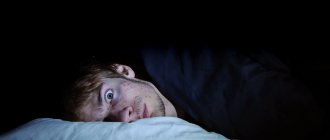Salary as of 08/27/2020Important qualitiesWhere to studyWhere to study
A somnologist is a specialist in sleep problems. The profession is suitable for those who are interested in chemistry, biology and psychology (see choosing a profession based on interest in school subjects). In 2020, the ProfGid career guidance center developed an accurate career guidance test. He himself will tell you which professions are suitable for you, and give an opinion about your personality type and intelligence.
Features of the profession
Somnology is a branch of medicine (sleep medicine) and neurobiology. She studies sleep, sleep disturbances and how these disturbances affect health. He also develops treatment methods. This is a rapidly growing medical specialty.
Somnologists study not only sleep disorders as such, but also diseases that can develop during sleep. Because It is known that during sleep, conditions such as stroke, asthma attacks, and heart attack are especially difficult.
There are many types of sleep disorders: from insomnia to narcolepsy, when a person falls asleep in broad daylight unexpectedly and for no apparent reason. Sleep problems also include night snoring and sleep apnea.
When a patient comes to a somnologist, the somnologist finds out the nature of the disorder. What exactly went wrong in the body? To make an accurate diagnosis, the somnologist needs to know whether the patient has problems in his personal life, at work, what kind of lifestyle he leads, what diseases he suffers from.
If necessary, the doctor prescribes additional tests. For example, polysomnography is a method in which sensors are put on a person before going to bed and various body functions are recorded throughout the night.
Scientists have identified fifty causes for insomnia alone. Often she may talk about some kind of hormonal disease (for example, diabetes). The cause may also be neurosis, problems in brain function, etc.
Having found out the source of the sleep problem, the somnologist prescribes treatment. If necessary, engages relevant specialists for consultations: an endocrinologist, a psychotherapist, an ENT doctor (for the treatment of snoring), etc.
What does a sleep doctor treat?
There are many disorders associated with altered sleep states. About five dozen reasons for ordinary (seemingly) insomnia. Among many others, there are such serious diseases as diabetes and hypertension. Narcolepsy is especially dangerous. This disorder is characterized by unexpected inclusion and, accordingly, exclusion from reality. People suffering from narcolepsy should not drive any vehicle. Sleep can turn off consciousness without any warning. A somnologist helps to find the origins of the disease, find and eliminate the root causes of serious and frightening symptoms.
Training to become a Somnologist
Having a medical diploma, you can take special courses to master this specialty. To conduct scientific research, a higher education in biology (Faculty of Biology) and specialization in the field of neurobiology are required. Currently, in Russia there is no specialization in somnology, so work in this area is carried out by doctors who have graduated from the Faculty of General Medicine, most often therapists, neurologists, cardiologists and pulmonologists. Since diagnostic and treatment methods are different, both otolaryngologists and orthodontists are involved. To work with instrumental diagnostic methods, primary retraining in functional diagnostics is required (for analyzing ambulatory monitors or polysomnography). Also in Moscow, some organizations conduct additional certification cycles in somnology, from 36 to 144 hours. Cycles of shorter duration are usually truncated prior to training in the diagnosis and treatment of obstructive sleep apnea. In recent years, short one-day seminars on the diagnosis and treatment of apnea have been held in various cities of Russia. For comparison, specialization in somnology exists in some foreign countries, usually lasting 1 year.
Courses
Case from practice
A forty-year-old man consulted a somnologist. He complained that for 10 years he had not known what healthy sleep was. The doctor suggested that he undergo polysomnography to understand how to treat the disease. The patient agreed. Studying the condition in conditions that are as similar as possible to a home environment has always given good results.
The room is cozy and dim. It is easy to breathe, the air is fresh, but not cold. The bed has an orthopedic mattress, even the bed linen smells pleasantly fresh and homely!
The patient knew that he would be monitored by a neurologist and a somnologist. Sensors, a computer, a special program for processing specific information - everything is ready for fruitful work. Finally, a person finds out what illness has been tormenting him for many years.
The man went into the laboratory and wished everyone good night... Five minutes later, the air space of the room exploded with severe snoring with pronounced apnea. The patient did not breathe for some time, then breathing returned noisily. The problem has been found. The man could not sleep deeply with such snoring. His sleep was superficial and incomplete, so it seemed to him that he was not sleeping at all. He slept in a separate room, there was no one to tell about the problems.
Treatment
There is no need to suffer from insomnia and suffer from chronic sleep deficiency. Contact your doctor and start treating your insomnia. Therapy, depending on the causes of the problem, may include several areas:
- Manual techniques: acupuncture, acupuncture, various massage techniques.
- It is possible to treat chronic insomnia with medications: antidepressants, antipsychotics, sedatives. But start taking it only after consulting a doctor, following the selected dosages and regimens. Self-medication is dangerous!
- Physiotherapeutic procedures (electrosleep).
- Mastering meditative techniques will teach you to relax, distract yourself from extraneous thoughts, quickly fall asleep and sleep all night without waking up.
- Hypnosis involves influencing the psyche, allowing you to penetrate consciousness, identify and eliminate the causes of sleep disorders.
- Breathing exercises. Concentrating on breathing and inhaling and exhaling in unusual ways will help you get rid of fears, relax, and normalize your heart rate.
- Folk remedies, for example, herbal teas with lemon balm, hawthorn, motherwort, mint, valerian. Decoctions can be added to the bath.
Relaxation techniques before bed
There are a variety of relaxation techniques before bed, and individual recommendations are made for each patient. The most common options:
- Relaxation before bed - quiet, calm music, knitting or embroidering, reading a book. You should not watch TV or engage in vigorous activities.
- Abdominal breathing - human breathing, as a rule, is very superficial; we inhale deeply only when visiting a doctor and at his request. In fact, deep, calm breaths involving the chest, abdomen and back help the nervous system relax, which in turn leads to normal sleep. For abdominal breathing, you need to close your eyes, take a deep and slow breath in through your nose and exhale through your mouth. Each next breath should be a little longer than the previous one. Repeat 5-7 times. You can perform 2-3 approaches.
- Progressive muscle relaxation - for this, a person must lie in bed and take the most comfortable position. Then you need to gradually, one by one, tense all the muscles of the body, starting with the legs. Tighten the muscles of your left leg for 10 seconds - relax, move to another muscle group, tense and relax again. And so on to the facial muscles.
Treatment at the Clinical Hospital on Yauza
With a prolonged course of the process, chronic insomnia develops. This condition is very dangerous due to its consequences and is not immediately treatable. In a state of normal sleep, the human brain continues intensive activity, processing information received during the day, restoring memory, and also plays an important role in eliminating toxins.
If the brain does not rest, there is a noticeable deterioration in the quality of life. Insomnia, the symptoms of which are manifested by emotional stress, is primary. For treatment, you can use herbal sedatives to help cope with anxiety and irritability.
Treatment of insomnia in Moscow at the Yauza Clinical Hospital involves two stages. To begin with, the factors causing lack of sleep are eliminated, and then individual drug therapy is prescribed.
Treatment methods for insomnia involve the use of medications whose effectiveness is aimed at restoring sleep structure. The choice of medications is based on fewer side effects and possible complications. The duration of treatment should not exceed 3 weeks. Otherwise, therapy may become addictive and dependent.
There are other ways to treat insomnia:
- Psychotherapy (autogenic training, hypnosis, group and individual sessions). Psychotherapy is also effective as pharmacotherapy, but is much less accessible due to the shortage of specialists and the cost of a standard hour of consultation.
- Phototherapy is the effect of bright white light on the brain through the eye system. This method allows you to control circadian rhythms (human biological clock), eliminating disturbances.
- Encephalophonia (brain music) – treatment with music, which is converted from the electroencephalogram of the patient himself. The conversion occurs using computer processing methods using a number of special algorithms. Encephalophonia is characterized by biological feedback.
Sign up for a consultation
Diagnostic methods
The main method for diagnosing insomnia is polysomnography, which gives a complete picture of the functioning of the body's systems at the time of sleep. To make a complete diagnosis, the doctor determines:
- stages of sleep;
- duration;
- correlation of physiological indicators with stages;
- cultural characteristics;
- behavioral character;
- psychological condition.
Thanks to this technique, the degree of the disease (primary, secondary) is determined. It is also possible to establish the main causes of disorders occurring in the body.
Which doctor should I consult if I suffer from insomnia?
Insomnia is a reason to visit a doctor. There is no doctor specializing in this disease. The causes of sleep disorders are varied, so you need to undergo a comprehensive examination, identify abnormalities and understand why the problem arose. Subject specialists and their specializations are discussed below.
Therapist or pediatrician
An adult should first contact a local physician. Parents should take the child or teenager to the pediatrician. The general practitioner will prescribe basic tests and diagnostic procedures, evaluation of the results of which will help identify abnormalities and refer the patient to a specialist.
The therapist or pediatrician, taking into account the patient’s complaints, will recommend blood tests (biochemical, general, hormone tests), electrocardiography, fluorography or x-ray examination of the lungs, ultrasound of internal organs (kidneys, bladder, liver, thyroid gland) and other tests and procedures.
Cardiologist
If your sleep is disturbed due to heart problems, you need to go to a cardiologist. The doctor will order an ECG and analyze the results to identify abnormalities. The specialist will recommend an ultrasound examination of the heart to evaluate heart contractions, organ size, structure and structure of valves, septa and other parts. To analyze the functioning of the heart muscle in different conditions, the doctor will prescribe daily monitoring (Holter monitoring) or exercise tests.
Neurologist
Human sleep depends on the functioning of the peripheral and central nervous systems, the study of which a neurologist specializes in. The doctor knows many diagnostic methods, thanks to which it will be possible to identify the causes of disorders. Having identified the pathology, the neurologist can recommend drug therapy and physiotherapeutic procedures.
Psychologist
If a person begins to complain of insomnia and psychological disorders, he should visit a psychologist. The specialist will conduct a conversation to assess the condition, identify deviations and provide assistance. A detailed, in-depth psychoanalysis will help you first determine what triggered the problems, and then influence the causes and eliminate the symptoms.
Psychiatrist or psychotherapist
Mental disorders require contacting a psychotherapist or psychiatrist. The doctor will conduct an examination, identify the causes of the disorders and prescribe treatment. Unlike psychology, psychiatry uses more rigorous but effective methods: training, group therapy sessions, medications.
Somnologist
Somnology is a young, developing field of medicine, so qualified specialists are available only in large cities and work in specialized specialized centers and clinics.
The tasks of a somnologist are to assess the quality and duration of night sleep, analyze the patient’s condition, and monitor brain functioning. Targeted comprehensive diagnostics will help identify the causes of insomnia.
Chiropractor
Manual therapy includes methods of diagnosis and therapy that involve the impact of a specialist’s hands on the patient’s body. The methods are aimed largely at the treatment of diseases of the musculoskeletal system, muscles and some internal organs.
Comic "Doctor Insomnia" - meta-despair, cyber-sex and quasi-drugs
Fantasy and hyperrealism, "futurelessness" and fatalism, despair and sex under stimulants - Disgusting men talk about the comic book "Doctor Insomnia" from Warren Ellis, the genius and freak of modern science fiction.
The plot of the comic is built around a mad scientist named John Reinhardt, who calls himself Doctor Insomnia. Reinhardt creates a sort of alter ego in the form of a caricatured mad scientist, oddly enough, under the influence of insomnia caused by stimulants and other narcotic substances.
Reinhardt has no time to sleep, because he has grandiose plans for his life. Doctor Insomnia's goal is simple - to create a revolution throughout the world, starting it in Havenside, his hometown, where he returns after several years of wandering in unknown places. At the same time, the revolution must be both technological and social. The mad scientist takes as his assistant a beautiful killer, whom he affectionately calls Sister Igor, and gets to work, pitting everyone against everyone - corrupt authorities against anarchists, drug dealers against drug addicts, and so on.
Meanwhile, in the city itself, various gangs are rampaging, as well as grinders - a subculture of lovers of sophisticated gadgets and biotechnologies. Prominent representatives of this movement are the Screamers, who have elevated mental and biological synchronization between people to a cult. Using special microchips located in nails or teeth, the girls are united into a single organism. If one of the Screamers experiences an orgasm, the rest of the members of the combined group also experience it at the same moment - an apparently beneficial symbiosis in which the entire group does not need to waste energy.
Despite the technological advancement of Havenside, which Dr. Insomnia once contributed to, people are not happy with what happened. Instead of the jet packs and flying cars that science fiction promised, they have mind-blowing sexual stimulants and improved Internet access through contact lenses in their eyes. Technology encourages animal instincts, but does not improve life - progress does not stop the destruction, but contributes to its even greater spread.
However, “Doctor Insomnia” is not a comic about revolution and the rotten society of the future, or rather not entirely about that. Ellis conceived the story of a mad scientist and “clumsy” technology in the early 2000s, but began writing the script only in 2006. “Doctor Insomnia” was released the following year.
For those who are not in the know, it was the mid-2000s that became the turning point in the “super-progress” of humanity, and these are not empty words. With the advent of social networks and vast resources such as Wikipedia, the Internet space finally began to acquire global proportions. The widespread development of cellular communications and other technologies has given rise to the confidence in many people that science will now advance even “broader” and “faster.”
This is debatable, but it is undeniable that science fiction changed thanks to this leap. SF authors almost never invented the future, but extrapolated the “future” of the ideas of their contemporary society. The ideas of modernists at the beginning of the last century and today's science fiction writers have changed dramatically, not least because of how inconsistent expectations about the future and reality are.
In our century, the “miracle” of technological progress has become so taken for granted that humanity has developed “fatigue of novelty.” Gibson promised us neuroimplants, and we received mobile phones, which today will not surprise anyone. We expected anthill cities, but what we got were overcrowded favelas. In times of constant change, people begin to feel as if nothing is happening at all. It is this feeling that Warren Ellis tries to convey through his Doctor Insomnia.
People are beginning to fear, albeit not fully consciously, the merging of technology and capitalism. When turning into cattle that can be sheared and equipped with unnecessary gadgets ceases to be illusory, nihilism and eschatological ideas about the future appear in society.
The philosophy of the Screamers in the comic reflects these ideas in a specific way. Girls stuff themselves with technology not in order to be “not like everyone else,” but in order not to feel loneliness in a world where everyone is “not like everyone else.” In general, grinders embrace an even more interesting concept where authenticity and self-improvement collide. They acquire gadgets to discard unnecessary human weaknesses in order to become even more humane.
Ellis's love for such countercultural modernizers of both society and himself is expressed in the words of Doctor Insomnia: "Be your own inventions."
By the way, the comic book is somewhat similar in some ways to the film “Re-Animator”, and not only by the main character. Stuart Gordon's 1985 film about the "adventures" of a scientist who sins against nature by raising the dead is based on the H. P. Lovecraft short story "Herbert West: Reanimator." In the comic book "Doctor Insomnia" Ellis also uses the setting and characters of the Lovecraftian universe, seasoned with modern technology. For example, there are several John Reinhardts in the city, one of them is even in prison. They appeared for some unknown reason, but in the comic there are clear hints about the occult reasons for this phenomenon.
The world of Doctor Insomnia is woven from advanced technology and despair caused by the inability of modern man to create a “meaningful” future. Warren Ellis's haunting, reality-based story and artist Ivan Rodriguez's stark vision create a comic book future that arrives faster than we know it.
“Someone stole your future. Have you ever wondered - who? Doctor Insomnia
Nervous insomnia
If somatic causes of insomnia, such as breathing problems, skin itching or pain, are not identified, the doctor will prescribe tests to detect neurological pathologies. EEG, ultrasound, MRI can detect disorders that cause insomnia. Their treatment allows you to improve your sleep. Treatment depends on the underlying disease. Reducing anxiety and treating neuroses help cope with the problem of insomnia. Along with medications, physiotherapy and psychotherapy, and training in relaxation techniques are used.











